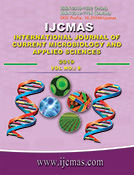


 National Academy of Agricultural Sciences (NAAS)
National Academy of Agricultural Sciences (NAAS)

|
PRINT ISSN : 2319-7692
Online ISSN : 2319-7706 Issues : 12 per year Publisher : Excellent Publishers Email : editorijcmas@gmail.com / submit@ijcmas.com Editor-in-chief: Dr.M.Prakash Index Copernicus ICV 2018: 95.39 NAAS RATING 2020: 5.38 |
Morphometric analysis with the help of Geographic Information System (GIS) is most effective, time saving and accurate technique for prioritization, planning and management, site specific suitability of various soil and water conservation measures and development and management of ground water on watershed basis. This study describes the morphometric analysis of Baruband watershed, Seoni district, Madhya Pradesh using remote sensing and GIS techniques for computation of morphometric parameter i.e linear, aerial and relief aspect and its use for planning of soil and water conservation measures. The analysis reveals that drainage pattern is dendritic and the maximum stream order of the watershed is four. The total number of stream of all orders is 119 with total length 5.995 km. Out of all order 50.45% covered by 1st order, 24.77% by 2nd order, 22.93% by 3rd order and 1.83% by 4th order. The drainage density of the watershed is 0.297 km / sqkm. The mean bifurcation ratio of the watershed is 5.20. The values obtained through morphometric analysis indicates that the watershed has low drainage density, permeable sub soil and flatter peak runoff for longer duration which can be manage easily as compare to circular shape basin. The present study demonstrates the usefulness of remote sensing and GIS techniques for computation of morphometric parameter.
 |
 |
 |
 |
 |